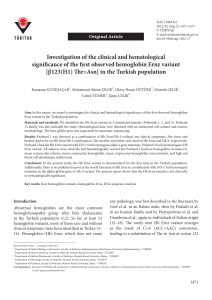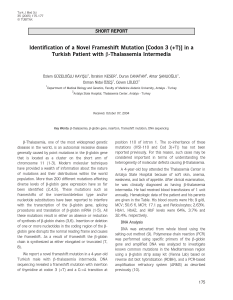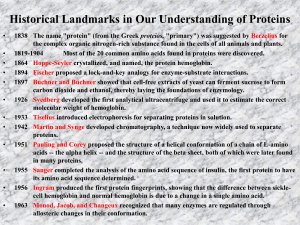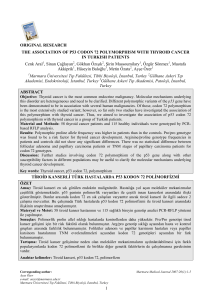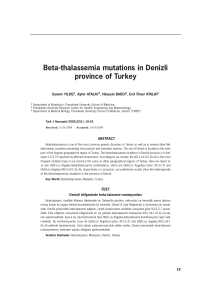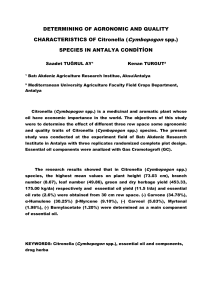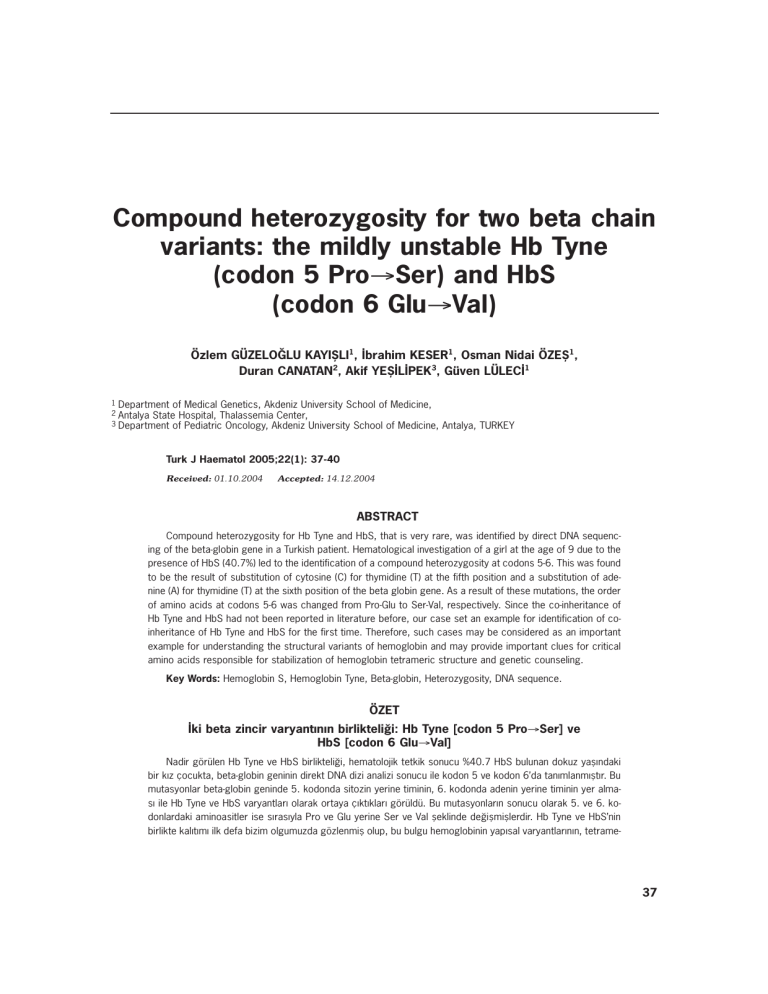
Compound heterozygosity for two beta chain
variants: the mildly unstable Hb Tyne
(codon 5 Pro→Ser) and HbS
(codon 6 Glu→Val)
Özlem GÜZELO⁄LU KAYIfiLI1, ‹brahim KESER1, Osman Nidai ÖZEfi1,
Duran CANATAN2, Akif YEfi‹L‹PEK3, Güven LÜLEC‹1
1
2
3
Department of Medical Genetics, Akdeniz University School of Medicine,
Antalya State Hospital, Thalassemia Center,
Department of Pediatric Oncology, Akdeniz University School of Medicine, Antalya, TURKEY
Turk J Haematol 2005;22(1): 37-40
Received: 01.10.2004
Accepted: 14.12.2004
ABSTRACT
Compound heterozygosity for Hb Tyne and HbS, that is very rare, was identified by direct DNA sequencing of the beta-globin gene in a Turkish patient. Hematological investigation of a girl at the age of 9 due to the
presence of HbS (40.7%) led to the identification of a compound heterozygosity at codons 5-6. This was found
to be the result of substitution of cytosine (C) for thymidine (T) at the fifth position and a substitution of adenine (A) for thymidine (T) at the sixth position of the beta globin gene. As a result of these mutations, the order
of amino acids at codons 5-6 was changed from Pro-Glu to Ser-Val, respectively. Since the co-inheritance of
Hb Tyne and HbS had not been reported in literature before, our case set an example for identification of coinheritance of Hb Tyne and HbS for the first time. Therefore, such cases may be considered as an important
example for understanding the structural variants of hemoglobin and may provide important clues for critical
amino acids responsible for stabilization of hemoglobin tetrameric structure and genetic counseling.
Key Words: Hemoglobin S, Hemoglobin Tyne, Beta-globin, Heterozygosity, DNA sequence.
ÖZET
‹ki beta zincir varyant›n›n birlikteli¤i: Hb Tyne [codon 5 Pro→Ser] ve
HbS [codon 6 Glu→Val]
Nadir görülen Hb Tyne ve HbS birlikteli¤i, hematolojik tetkik sonucu %40.7 HbS bulunan dokuz yafl›ndaki
bir k›z çocukta, beta-globin geninin direkt DNA dizi analizi sonucu ile kodon 5 ve kodon 6’da tan›mlanm›flt›r. Bu
mutasyonlar beta-globin geninde 5. kodonda sitozin yerine timinin, 6. kodonda adenin yerine timinin yer almas› ile Hb Tyne ve HbS varyantlar› olarak ortaya ç›kt›klar› görüldü. Bu mutasyonlar›n sonucu olarak 5. ve 6. kodonlardaki aminoasitler ise s›ras›yla Pro ve Glu yerine Ser ve Val fleklinde de¤iflmifllerdir. Hb Tyne ve HbS’nin
birlikte kal›t›m› ilk defa bizim olgumuzda gözlenmifl olup, bu bulgu hemoglobinin yap›sal varyantlar›n›n, tetrame-
37
Güzelo¤lu Kay›fll› Ö, Keser ‹, Özefl ON,
Canatan D, Yeflilipek A, Lüleci G.
Compound heterozygosity for two beta chain variants: the mildly
unstable Hb Tyne (codon 5 Pro→Ser) and HbS (codon 6 Glu→Val)
rik yap›s›n›n stabilizasyonu için sorumlu kritik aminoasitlerin öneminin anlafl›lmas›nda ve do¤ru genetik dan›flma verilmesinde önemli rol oynayabilir.
Anahtar Kelimeler: Hemoglobin S, Hemoglobin Tyne, Beta-globin, Heterozigosite, DNA dizi analizi.
INTRODUCTION
Hemoglobinopathies are known as the
most common single gene defects in the
world population. About 5% of world’s population are carriers of different inherited
hemoglobin (Hb) and thalassemia disorders,
and more than 300.000 severely affected
homozygous or compound heterozygous are
born each year[1]. Different structural hemoglobin variants have been reported using
hemoglobin electrophoresis and molecular
techniques. While about half of these variant
are clinically silent, other half that are not
silent generally generate a change in oxygen
affinity or a physically unstable Hb molecule[1-4]. Sickle cell hemoglobin (HbS) that is
the most common Hb variant was firstly
identified as abnormal hemoglobin and has
great clinical importance because of causing
hemolytic anemia. In HbS, a single glutamic
acid residue on beta-globin chain or chains
is replaced by valine residue (codon 6 Glu
→Val). This single amino acid change results
in decreased ability of globin to transport
oxygen. Homozygous, heterozygous, betathalassemia/sickle cell, or other compound
heterozygous are the phenotypic consequences of the mode of inheritance[5-7]. The
unstable hemoglobin disorders result from
the presence of structurally abnormal hemoglobin variant with substitution or deletion of
amino acid in globin chains[8]. Unstable
hemoglobin variants are either degraded
before the tetramer assembly or immediately
after it is made in the bone marrow[9]. To
date, different unstable hemoglobin variants
have been illustrated. These hyper unstable
variants offer important clues to identify
structurally critical areas of the hemoglobin
tetramer[10]. Langdown JV et al firstly discovered Hb Tyne in two unrelated English citizens in 1994. Hb Tyne (codon 5 C → T) re-
38
sults from a single amino acid change in beta-globin polypeptide: a substitution of proline for serine at the fifth position of the betaglobin polypeptide (codon 5 Pro → Ser). They
hypothesized that this mutation causes formation of mildly unstable hemoglobin[11]. We
know that the co-inheritance of two Hb variant in a patient is very uncommon. Here, we
are reporting the co-inheritance of Hb Tyne
(codon 5 Pro → Ser) and HbS (codon 6 Glu →
Val) in a 9-years-old girl diagnosed clinically
with beta-thalassemia/HbS for the first time.
A CASE REPORT
A 9-years-old girl was referred to
Thalassemia Center, Antalya State Hospital
because of soft skin, anemia, weakness, and
lack of appetite, two years ago. After clinical
examination and HbS, HbF, HbA2 values
were determined by HPLC, then she was
diagnosed as sickle cell anemia and betathalassemia due to increased level of HbS,
HbF, HbA2. In physical examination: weight:
14 kg, height: 102 cm, liver: 2 cm, spleen: 4
cm, and blood count showed the following
values: RBC: 2.11 x 1012/L, Hb: 6.6 g/dL,
MCV: 73.1 fL, MCH: 31.3 pg, HbA1: 42.5%,
HbA2: 3.9%, HbF: 6.1%, HbS: 40.7%. Blood
transfusion was annually 7-8 units.
DNA Analysis
DNA was extracted from whole blood
using salting-out method[12]. Polymerase
chain reaction (PCR) was performed by specific primers of beta-globin gene and amplified DNA was analyzed to investigation
known common mutations in Mediterranean
Region using β-Globin Strip Assay kit
(Vienna Lab) based on reverse dot blot
hybridization (RDBH). To confirm the presence of HbS allele DdeI restriction enzyme
analysis was performed. To explore the other
mutations in beta-globin gene, DNA including
Turk J Haematol 2005;22(1):37-40
Compound heterozygosity for two beta chain variants: the mildly
unstable Hb Tyne (codon 5 Pro→Ser) and HbS (codon 6 Glu→Val)
Güzelo¤lu Kay›fll› Ö, Keser ‹, Özefl ON,
Canatan D, Yeflilipek A, Lüleci G.
approximately 700 bp was amplified using
amplification primers (Primer F: 5’- GCCAAGGACAGGTACGGCTGTCAT C-3’ and Primer R:
5’-CCCTTCCTATGACATGA ACTTAACCAT-3’)
designed for the initial site of the beta-globin
gene. PCR product was separated in a 1.5%
agarose gel. The amplified fragment was eluted from agarose gel using purification kit
(MBI Fermantas, K0513, Iontek, Bursa,
Turkey). Chain termination sequencing with
ddNTPs and [α-35S]-dATP was performed on
single-stranded PCR templates[13].
RESULTS
The A → T substitution at codon 6 was
screened by RDBH and confirmed by DdeI
restriction enzyme analysis. DNA sequencing
of the patient’s beta-globin gene demonstrated two substitutions in codon 5 and 6: both
a substitution of cytosine (C) for thymidine
(T) at the fifth position and a substitution of
adenine (A) for thymidine (T) at the sixth position of the beta-globin gene (Figure 1). Due
to these mutations normal amino acids (Pro-Glu) in beta globin polypeptide were changed to (Ser--Val), respectively according to
the following schema:
Normal allele codons: ACT CCT GAG GAG
Mutant allele codons: ACT TCT GTG GAG
Normal amino acids: Thr Pro Glu Glu
Mutant amino acids: Thr Ser Val Glu
After two years, blood count of the
proband changed the following values: RBC:
2.5 x 1012/L, Hb: 11.0 g/dL, MCV: 94.4 fL,
MCH: 30.70 pg, MCHC: 35.20 g/dL, RDW:
16.90%, HbA1: 45.0%, HbA2: 4.4%, HbF:
26.5%, HbS: 24.5%. Blood transfusion was
annually decreased from 7-8 units to 2-3. In
addition, serum electrolite levels were found
as the following values: Na: 141.00 mEq/L, K:
3.91 mEq/L, Cl: 104.00 mEq/L, Ca: 9.50
mg/dL, and glucose: 88.00 mg/dL, creatinine:
0.24 mg/dL, serum albumin: 3.70 g/dL.
Proband’s father was found as a carrier
for Hb Tyne, and mother for HbS. The hematological parameters of father and mother were HbA1 (52%), HbA (4.4%), HbF
Turk J Haematol 2005;22(1):37-40
Figure 1. Direct DNA sequence analysis of the mutated strand of a beta-globin gene PCR fragment from the
compound heterozygous for Hb Tyne and HbS
proband. The normal sequence is shown on the left,
and the mutated sequence on the right. The base where
substitution of cytosine (C) for tymidine (T) in codon
5 are indicted by a asterisk (*).
(1.0%), HbS (36.7%), Hb: 15.6 g/dL, Hct:
46.5%, MCV: 85.4 fL, MCH: 28.7 pg,
MCHC: 33.5 g/dL, RDW: 15.1%, and HbA1
(46.7%), HbA2 (5.0%), HbF (0.3%), HbS
(48.0%), Hb: 13.9 g/dL, Hct: 40.8%, MCV:
93.2 fL, MCH: 31.7 pg, MCHC: 34.1 g/dL,
RDW: 13.7%, respectively. DNA sequencing
of the patient’s beta-globin gene is shown
in Figure 1.
DISCUSSION
Hereditary disorders that result in structurally abnormal hemoglobin or an insufficient quantity of Hb are the most common
human genetic diseases. Most mutations in
the globin genes are a single base pair
change in DNA code resulting in amino acid
substitutions[1]. Sickle cell anemia is caused
by a GAG substitution in codon 6 of betasubunit of hemoglobin that produces a
39
Güzelo¤lu Kay›fll› Ö, Keser ‹, Özefl ON,
Canatan D, Yeflilipek A, Lüleci G.
structural variant of Hb, HbS. Due to the
historical migration of different ethnic
groups, HbS does not show homogeneously
distribution in Turkey, and generally is common in South-eastern coasts, and
Mediterranean region[14]. While South-eastern coasts, known as Çukurova region in
where the disease frequency varies from 0.3
to 37%[10]. The incidence of HbS was found
to have 10.3% in Antalya[15]. Although the
co-inheritance of two Hb variant in a patient
is very uncommon, the presence of the
patient’s co-inheritance sickle cell anemia
with another globin gene disorders such as
beta-thalassemia, other hemoglobin variants
due to this relatively high incidence of HbS in
Antalya population is not surprising. The
unstable hemoglobin disorders result from
the presence of structurally abnormal hemoglobin variant with substitution or deletion of
amino acid in globin chains[1,4]. Langdown et
al first discovered Hb Tyne in two unrelated
English citizens. Hb Tyne (codon 5 C → T)
has previously been characterized as mildly
unstable hemoglobin varint [11]. In this
study, we firstly describe a Turkish patient
who carried HbS at codon 6 and hemoglobin
Tyne codon 5. After HbS and HbF level were
shown to be high using electrophoresis, genotype of the patient was found to be a compound heterozygote for HbS and Hb Tyne by
molecular studies. The hydroxyurea (HU)
(20 mg/kg/day) had been used to decrease
the clinical severity for last two years of her
life, and blood transfusion necessity of the
proband was decreased from 7-8 to 2-3
units, annually. We observed a very good clinical response to HU treatment, and HbF
was increased from 6.1% to 26.5% during
two years. Also, MCV and Hb levels were found to be increased, 83.4 fL versus 94.4 fL
and 8.3 g/dL versus 9.4 g/dL, respectively.
As a conclusion, this report of the coinheritance of HbS and Hb Tyne may be very
important to understand molecular mechanisms of globin gene and may assist to physicians for management of treatment strategies and genetic counseling.
40
Compound heterozygosity for two beta chain variants: the mildly
unstable Hb Tyne (codon 5 Pro→Ser) and HbS (codon 6 Glu→Val)
REFERENCES
1.
2.
3.
4.
5.
6.
7.
8.
9.
10.
11.
12.
13.
14.
15.
Weatherall DJ, Clegg JB, Higgs DR, Wood WG. The
hemoglobinopathies. In: Scriver CR, Beaudet A, Sly
WS, Valle D (eds). The Metabolic and Molecular
Bases of Inherited Disease. New York: McGraw-Hill,
1989:3417-83.
Sack GH. Autosomal recessive disorders. Medical
Genetics. New York, USA: McGraw-Hill, 1999:61-3.
Thompson MW, McInnes RR, Willard HF.
Hemoglobinopathies. In: Genetics in Medicine.
Philadelphia: WB Saunders Company, 1991:247-69.
Maeda M, Yamamoto M. The unstable hemoglobin
disease. Nippon Rinsho 1996;54:2436-41.
Trent RJ. Medical genetics. Molecular Medicine.
Singapore: Longman Singapore Ltd, 1997:37-71.
Ho PJ, Thein SL. Gene regulation and deregulation:
a β globin perspective. Blood Rev 2000;14:78-93.
Weatherall DJ. The thalassemias. In: Stamatoyannopoulos G, Nienhuis AW, Majerus PH, Varmus H
(eds). The Molecular Basis of Blood Diseases. 2nd
ed. Philadelphia: WB Saunders Company, 1994:
157-205.
Wajman H, Galacteros F. Abnormal hemoglobin
with high oxygen affinity and eryhrocytosis. Hematol
Cell Ther 1996;38:305-12.
Oner R, Altay C, Gurgey A, et al. Beta thalassemia
in Turkey. Hemoglobin 1990;14:1-13.
Tadmouri GO, Tuzmen S, Ozcelik H, Ozer A, Baig
SM, Senga EB, Basak AN. Molecular and population
genetic analyses of beta-thalassemia in Turkey. Am J
Hematol 1998;57:215-20.
Langdown JV, Williamson D, Beresford CH, Gibb I,
Taylor R, Deacon-Smith R. A new beta chain variant, Hb Tyne [beta 5 (A2)Pro → Ser]. Hemoglobin
1994;18:333-6.
Miller SA, Dykes DD, Polesky MF. A simple salting
out procedure for extracting DNA from human
nucleated cells. Nucleic Acids Res 1988;16:1215.
Sanger F, Coulson AR. A rapid method for determining sequences in DNA by primed synthesis with
DNA polymerase. J Mol Biol 1975;94:441-6.
Altay C. Abnormal hemoglobins in Turkey. Turk J
Heamatol 2002;19:63-74.
Keser I, Sanlioglu AD, Manguoglu E, et al. Molecular
analysis of beta-thalassemia and sickle cell anemia in
Antalya. Acta Haematol 2004;111:205-10.
Address for Correspondence:
İbrahim KESER, MD
Department of Medical Genetics
Akdeniz University School of Medicine
Antalya, TURKEY
e-mail: [email protected]
Turk J Haematol 2005;22(1):37-40

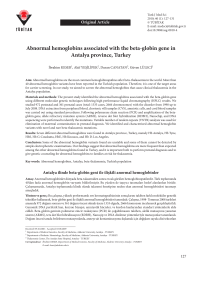
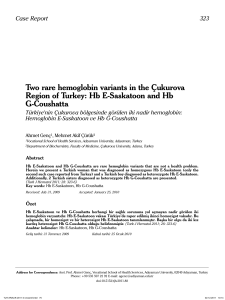
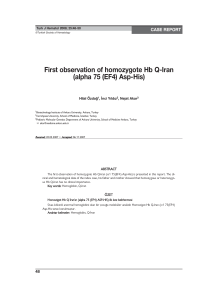
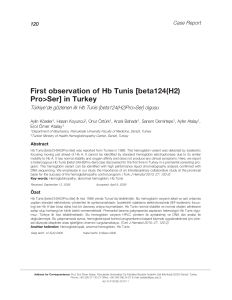

![First observation of Hb D-Ouled Rabah [beta19(B1)Asn>Lys] in the](http://s1.studylibtr.com/store/data/003346881_1-fc6465a17750760535fb52bbef4ddf81-300x300.png)
